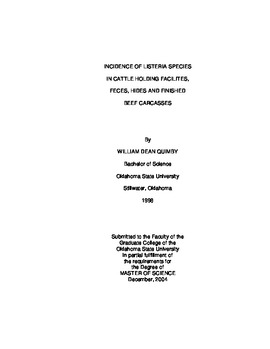| dc.description.abstract | The purpose of this study was to test for the incidence of Listeria species in environmental samples of automatic watering systems, composite fecal samples from cattle production facilities, direct fecal samples collected from cattle at both production and slaughter, the hides of the cattle during the slaughter process as well as the finished carcasses. Environmental sampling of the abattoir was also performed for Listeria both before and after slaughter. Conventional plating and identification methods were performed as outlined by the USDA for isolating Listeria monocytogenes. Additional analysis of isolates was performed using a commercially available PCR kit as well as Pulsed Gel Field Electrophoresis utilizing restriction enzymes SmaI and AscI. A total of 870 samples were collected, of which 97 (11.1%) were positive for Listeria species and 1 (0.11%) was positive for Listeria monocytogenes. In the livestock production environment, samples collected included 22 water troughs, 91 composite fecal and 360 individual samples. Of these, 1, 16 and 11 were positive for Listeria species, respectively, and 1, a composite fecal sample, was positive for Listeria monocytogenes. At the abattoir, 119 individual fecal, 33 hide, 106 carcass and 139 environmental samples were collected, of which 21, 26, 9, and 13 were positive for Listeria species, respectively. Genetic analysis utilizing Pulsed Field Gel Electrophoresis demonstrated that specific strains of Listeria have the ability to survive and persist in the production environment, be shed in the feces of cattle, contaminate the hides of cattle and ultimately contaminate carcasses. Even though a direct progression from the feedlot to the feces to the hide to the carcass may not always be evident, the fact remains isolates recovered from the animal production environment were found on finished carcasses, indicating the need for intervention steps. | |
